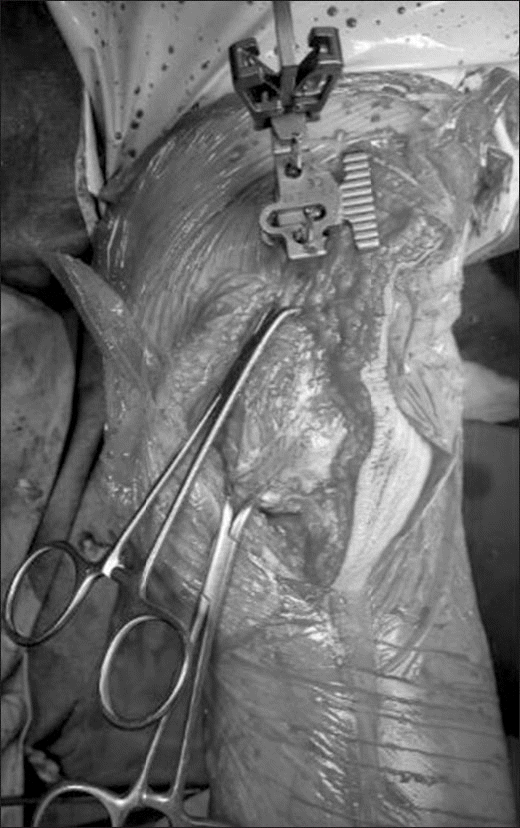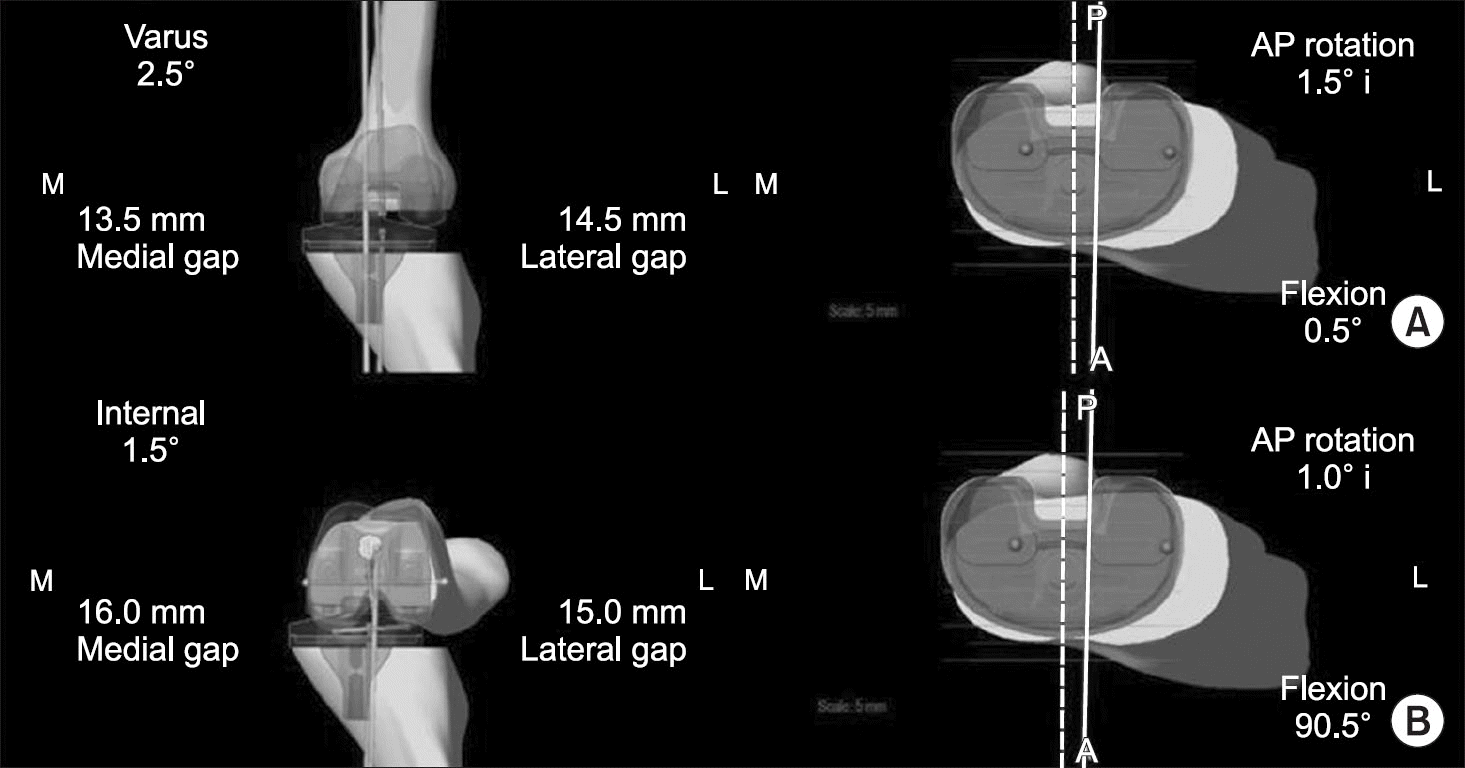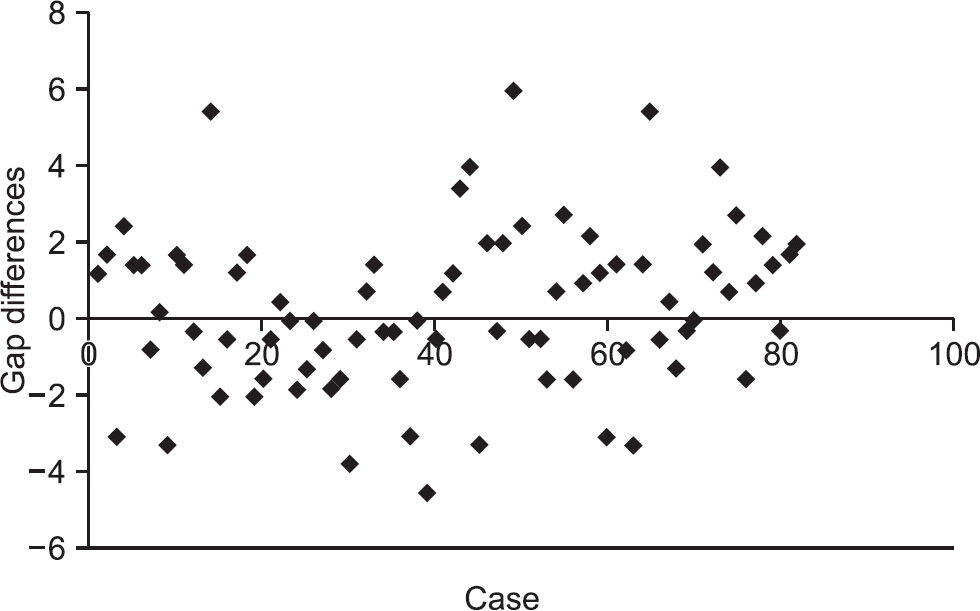Abstract
Purpose:
To evaluate the relationship between the knee function at 1 year postoperation and the gap difference (90˚ flexion gap–extension gap) in total knee replacement.
Materials and Methods:
Eighty-two consecutive osteoarthritis knees that underwent primary total knee replacement using navigation from March 2017 June 2017 were evaluated prospectively. The gap was measured using navigation after reducing the patella with towel clips. After checking the average values of the medial and lateral gaps at extension and 90˚ flexion knee, the gap difference (90˚ flexion gap–extension gap) was calculated. The knees were divided into three groups according to the gap difference (gap difference<0 mm, 0 mm≤gap difference<2 mm, 2 mm≤gap difference). The Knee Society score (KSS) and maximal knee flexion were compared at 1 year postoperation among three groups.
Results:
The numbers of knees according to groups were 37, 29, and 16 knees in regular order. The average of the KSS knee, KSS function, and maximal knee flexion at the 1-year follow-up were 81.21±8.31, 71.34±9.84, and 126.48˚±7.28˚, respectively. No statistically significant difference in KSS was observed among the 3 groups. The third group (2 mm≤gap difference) showed a larger maximal knee flexion than the other groups in the Mann–Whitney test.
Go to : 
References
1. Griffin FM, Insall JN, Scuderi GR. Accuracy of soft tissue balancing in total knee arthroplasty. J Arthroplasty. 2000. 15:970–3.

2. Jawhar A, Hutter K, Scharf HP. Outcome in total knee arthroplasty with a medial-lateral balanced versus unbalanced gap. J Orthop Surg (Hong Kong). 2016. 24:298–301.

3. Gustke KA, Golladay GJ, Roche MW, Elson LC, Anderson CR. A new method for defining balance: promising short-term clinical outcomes of sensor-guided TKA. J Arthroplasty. 2014. 29:955–60.
4. Lee DH, Shin YS, Jeon JH, Suh DW, Han SB. Flexion and extension gaps created by the navigation-assisted gap technique show small acceptable mismatches and close mutual correlations. Knee Surg Sports Traumatol Arthrosc. 2014. 22:1793–8.

5. Matsui Y, Nakagawa S, Minoda Y, Mizokawa S, Tokuhara Y, Kadoya Y. Joint gap measurement in total knee arthroplasty using a tensor device with the same articulating surface as the prosthesis. Arch Orthop Trauma Surg. 2014. 134:699–705.

6. Seon JK, Song EK, Park SJ, Lee DS. The use of navigation to obtain rectangular flexion and extension gaps during primary total knee arthroplasty and midterm clinical results. J Arthroplasty. 2011. 26:582–90.

7. Baldini A, Scuderi GR, Aglietti P, Chalnick D, Insall JN. Flexion-extension gap changes during total knee arthroplasty: effect of posterior cruciate ligament and posterior osteophytes removal. J Knee Surg. 2004. 17:69–72.
8. Ismailidis P, Kuster MS, Jost B, Giesinger K, Behrend H. Clinical outcome of increased flexion gap after total knee arthroplasty. Can controlled gap imbalance improve knee flexion? Knee Surg Sports Traumatol Arthrosc. 2017. 25:1705–11.
9. Jeffcote B, Nicholls R, Schirm A, Kuster MS. The variation in medial and lateral collateral ligament strain and tibiofemoral forces following changes in the flexion and extension gaps in total knee replacement. A laboratory experiment using cadaver knees. J Bone Joint Surg Br. 2007. 89:1528–33.

10. Kadoya Y, Kobayashi A, Komatsu T, Nakagawa S, Yamano Y. Effects of posterior cruciate ligament resection on the tibiofemoral joint gap. Clin Orthop Relat Res. 2001. 391:210–7.

11. Romero J, Stähelin T, Binkert C, Pfirrmann C, Hodler J, Kessler O. The clinical consequences of flexion gap asymmetry in total knee arthroplasty. J Arthroplasty. 2007. 22:235–40.

12. Viskontas DG, Skrinskas TV, Johnson JA, King GJ, Wine-maker MJ, Chess DG. Computer-assisted gap equalization in total knee arthroplasty. J Arthroplasty. 2007. 22:334–42.

13. In Y, Kim SJ, Kim JM, Woo YK, Choi NY, Kang JW. Agreements between different methods of gap balance estimation in cruciate-retaining total knee arthroplasty. Knee Surg Sports Traumatol Arthrosc. 2009. 17:60–4.

14. Winemaker MJ. Perfect balance in total knee arthroplasty: the elusive compromise. J Arthroplasty. 2002. 17:2–10.

15. Yagishita K, Muneta T, Ikeda H. Step-by-step measurements of soft tissue balancing during total knee arthroplasty for patients with varus knees. J Arthroplasty. 2003. 18:313–20.

16. Lampe F, Marques CJ, Fiedler F, Sufi-Siavach A, Matziolis G. Do well-balanced primary TKA patients achieve better outcomes within the first year after surgery? Orthopedics. 2016. 39::S6-12.

17. Gejo R, Morita Y, Matsushita I, Sugimori K, Kimura T. Joint gap changes with patellar tendon strain and patellar position during TKA. Clin Orthop Relat Res. 2008. 466:946–51.

18. Lombardi AV Jr, Mallory TH, Vaughn BK. . Dislocation following primary posterior-stabilized total knee arthroplasty. J Arthroplasty. 1993. 8:633–9.

19. Matsumoto T, Mizuno K, Muratsu H. . Influence of intra-operative joint gap on post-operative flexion angle in osteoarthritis patients undergoing posterior-stabilized total knee arthroplasty. Knee Surg Sports Traumatol Arthrosc. 2007. 15:1013–8.

20. van der Linden-van der Zwaag HM, Valstar ER, van der Molen AJ, Nelissen RG. Transepicondylar axis accuracy in computer assisted knee surgery: a comparison of the CT-based measured axis versus the CAS-determined axis. Comput Aided Surg. 2008. 13:200–6.
Go to : 
 | Figure 1.To obtain post total knee arthroplasty status gap, gap after patella reduction was measured using towel clips. |
 | Figure 2.Soft tissue release and extension-flexion gaps were controlled by viewing the navigation screen displacing the extension and flexion gaps. AP, anteroposterior. |
Table 1.
Patients’∗ Demographic Details
Table 2.
Gaps Displaced on Navigation after Mounting the Implant
Table 3.
Knee Function according to X (90° Flexion Gap–Extension Gap, mm) after 1 Year Postoperation
Table 4.
Comparison of the Knee Maximal Flexion Degrees at 1 Year Postoperation between the Groups according to X (90˚ Flexion Gap–Extension Gap, mm)
| Group 1 | Group 2 | p-value |
|---|---|---|
| X<0 | 0≤X<2 | 0.14 |
| X<0 | 2≤X | <0.001 |
| 0≤X<2 | 2≤X | 0.01 |
Table 5.
Comparison of the Preoperation Variables among the Groups according to X (90˚ Flexion Gap–Extension Gap, mm)




 PDF
PDF ePub
ePub Citation
Citation Print
Print



 XML Download
XML Download